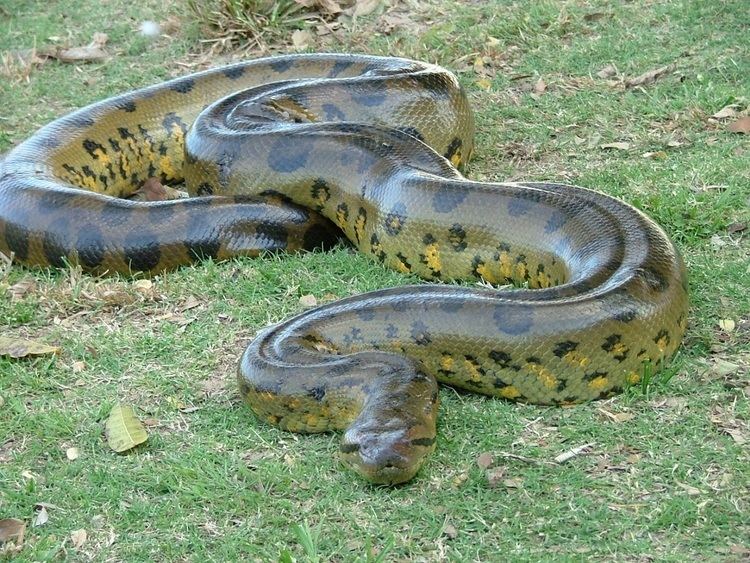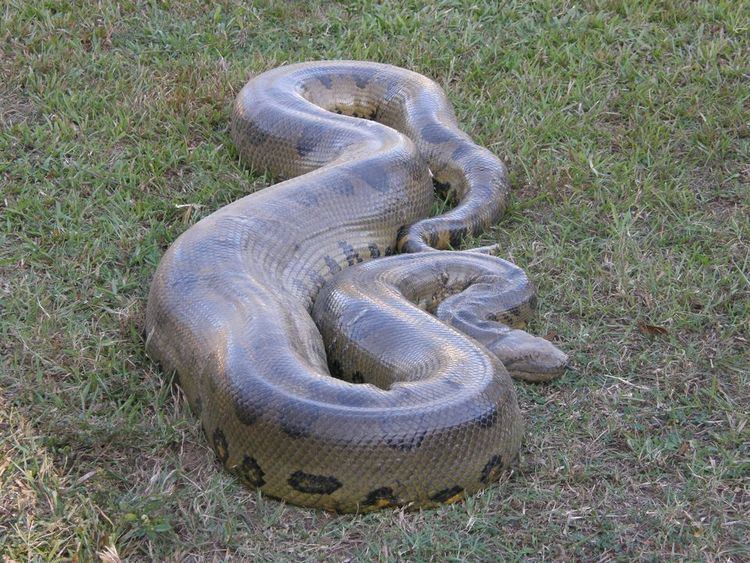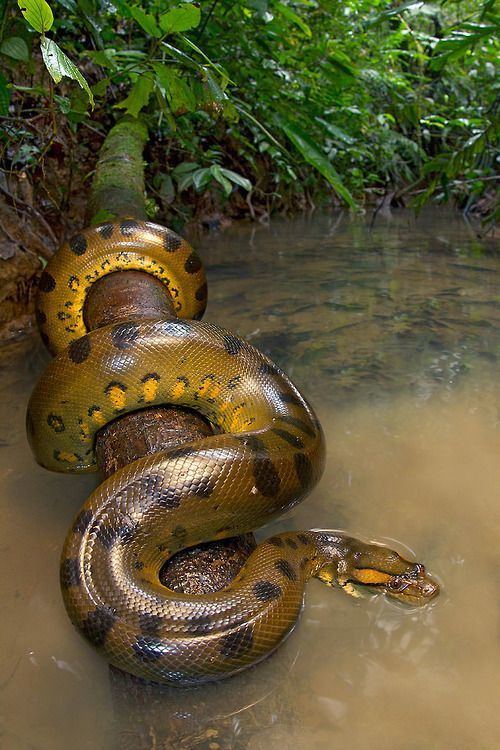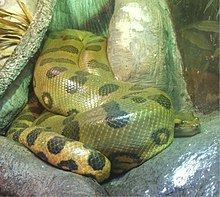 | ||
Length Female: 4.6 m (Adult), Male: 3 m (Adult) Similar Snake, Anaconda, Python family, King cobra, Python | ||
In search of the giant green anaconda eunectes murinus video
The green anaconda (Eunectes murinus), also known as the common anaconda and water boa, is a non-venomous boa species found in South America. It is the heaviest and one of the longest known extant snake species. The term anaconda often refers to this species, though the term could also apply to other members of the genus Eunectes.
Contents
- In search of the giant green anaconda eunectes murinus video
- The green anaconda song
- Description
- Difficulties in determining maximum size
- Historical records
- Current estimates of maximal size
- Scientific and common names
- Geographic range
- Behavior
- Feeding
- Reproduction
- Captivity
- Subspecies
- In popular culture
- References

The green anaconda's scientific name is derived from the Greek εὐνήκτης, meaning "good swimmer", and the Latin murinus, meaning "of mice", for being thought to prey on mice.

The green anaconda song
Description

The green anaconda is the world's heaviest and one of the world's longest snakes, reaching 5.21 m (17.1 ft) long. More typical mature specimens reportedly can range up to 5 m (16.4 ft), with the females, at around a mean length of 4.6 m (15.1 ft), being generally much larger in adulthood than the male, which averages around 3 m (9.8 ft). Weights are less well studied, though will reportedly range from 30 to 70 kg (66 to 154 lb) in an average-range adult. It is the largest snake native to the Americas. Although it is slightly shorter than the reticulated python, it is far more robust: the bulk of a 4.5m green anaconda would be comparable to a 7.4m reticulated python. Eunectes murinus is probably the heaviest extant species of snake or squamate in the world, perhaps only rivaled by the Komodo dragon. Reports of anacondas 35–40 feet or even longer also exist, but such claims need to be regarded with caution, as no specimens of such lengths have ever been deposited in a museum and hard evidence is lacking. A $50,000 cash reward is offered for anyone who can catch an anaconda 30 ft (9.1 m) or longer, but the prize has not been claimed yet. The longest (and heaviest) verified specimen encountered by Dr. Jesús Antonio Rivas, who had examined thousands of anacondas, was a female measuring 521 cm (17.09 ft) long and weighing 97.5 kg (215 lb).

The color pattern consists of olive green background overlaid with black blotches along the length of the body. The head is narrow compared to the body, usually with distinctive orange-yellow striping on either side. The eyes are set high on the head, allowing the snake to see out of the water while swimming without exposing its body.
Difficulties in determining maximum size

The remote location of the snake's habitat has historically made locating, capturing, and returning specimens difficult. Transporting very large specimens to museums, especially before substantial decay, is difficult (though this has not prevented the return of much larger and more cumbersome crocodilian specimens). Skins can stretch substantially, increasing the snake's size by more than 50% if stretched during the tanning process. Reports without physical proof are considered dubious if from nonscientists, as such individuals may at worst be more interested in promoting themselves or telling a good tale, or at the least may not be sufficiently trained in proper measurement methods. Observational reports of animals which were not captured are even more dubious, as even trained scientists often substantially overestimate the size of anacondas prior to capture. According to the Guinness Book of World Records, this species has been perhaps subject to the most extreme size exaggerations of any living animal. At the same time, it is difficult to argue a maximum possible or plausible size, because anacondas are known to continue to grow throughout their lives. Older reports in particular could include individuals which, in times of less pressure from humans, lived longer lives and thus reached greater sizes.
Historical records
Numerous historical accounts of green anacondas are reported, often of improbable sizes. Several zoologists (notably Henry Walter Bates and Alfred Russel Wallace, among others) note rumors of snakes beyond 30 or 40 feet long, but in each case, their direct observations were limited to snakes of approximately 20 feet in length. Numerous estimates and second-hand accounts abound, but are generally considered unreliable. To prove the point of overestimating, in Guyana in 1937, zoologist Alpheus Hyatt Verrill asked the expedition team he was with to estimate the length of a large, curled-up anaconda on a rock. The team's guesses ran from 6.1 to 18.3 m (20.0 to 60.0 ft); when measured, this specimen was found to be 5.9 m (19.4 ft).
Almost all specimens in excess of 6 m (19.7 ft), including a much publicized specimen of 11.36 m (37.3 ft) in length, have no voucher specimens, including skins or bones.
The skin of one specimen, stretched to 10 m (32.8 ft), has been preserved in the Instituto Butantan in São Paulo and is reported to have come from an anaconda of 7.6 m (24.9 ft) in length. In one of the most reliable accounts, a geologist killed a large anaconda and measured it using a four-meter rod, reporting it as three rods long (12 m (39.4 ft)); however, the information was not published until many years later, and the geologist later suggested he may have misremembered and the anaconda could have been only two rods long (8 m (26.2 ft)). While in Colombia in 1978, herpetologist William W. Lamar had an encounter with a large female specimen which measured 7.5 m (24.6 ft) and was estimated to weigh between 136 and 180 kg (300 and 397 lb). In 1962, W.L. Schurz claimed to have measured a snake in Brazil of 8.46 m (27.8 ft) with a maximum girth of 112 cm (3.67 ft). One female, reportedly measuring 7.9 m (25.9 ft) in length, shot in 1963 in Nariva Swamp, Trinidad, contained a 1.5-m caiman. A specimen of 7.3 m (24.0 ft), reportedly with a weight of 149 kg (328 lb), was caught at the mouth of the Kassikaityu River in Guyana, having been restrained by 13 local men, and was later air-lifted for a zoo collection in the United States, but died in ill health shortly thereafter. The largest size verified for E. murinus in captivity was for a specimen kept in Pittsburgh Zoo and PPG Aquarium, which grew to a length of 6.27 m (20.6 ft) by the time she died on July 20, 1960. When this specimen was 5.94 m (19.5 ft) long, she weighed 91 kg (201 lb). The estimated weight for an anaconda in the range of 8 m (26.2 ft) is at least 200 kg (440 lb). National Geographic has published a weight of up to 227 kg (500 lb) for E. murinus, but this is almost certainly a mere estimation. Weight can vary considerably in large specimens depending on environmental conditions and recent feedings, with Verrill's aforementioned specimen, having been extremely bulky, scaled at 163 kg (359 lb), whereas another specimen considered large at 5.06 m (16.6 ft), weighed only 54 kg (119 lb).
Current estimates of maximal size
Size presents challenges to attain breeding condition in larger female anacondas and while larger sizes provide the benefit of larger number of offspring per clutch, the breeding frequency of the individuals reduces with size, indicating that there's a point in which the advantage of larger clutch size is negated by the female no longer being able to breed, for the anaconda, this limit was estimated at approximately 6.7 m (22.0 ft) in total length. This is consistent with the results of a revision of the size at maturity and maximum size of several snakes from North America, which found that the maximum size is between 1.5 and 2.5 the size at maturity. The minimum size of breeding anacondas in a survey of 780 individuals was 2.1 m (6.9 ft) in snout-vent length, indicating that maximum size attained by anacondas following this pattern would be 5.3 m (17.4 ft) in snout-vent length. However, most anacondas are captured from the llanos, which is more accessible to humans and has smaller prey available, while the rainforest, which is much less explored and has more plentiful large prey, may be home to larger snakes.
Scientific and common names
In the famous 10th edition of Systema Naturae of 1758, Carl Linnaeus cited descriptions by Albertus Seba and by Laurens Theodorus Gronovius to erect the distinct species murina of his new genus Boa, which contained eight other species, including boa constrictor. The generic name Boa came from an ancient Latin word for a type of large snake. The first specimens of Boa murina were of immature individuals from 2.5 to 3.0 feet (75 to 90 cm) in length. In 1830, Johann Georg Wagler erected the separate genus Eunectes ("good swimmer" in Greek) for Linnaeus’s Boa murina after more and larger specimens were known and described. Because of the masculine gender of Eunectes, the feminine Latin specific name murina was changed to murinus.
Linnaeus almost certainly chose the scientific name Boa murina based on the original Latin description given by A. Seba in 1735: "Serpens testudinacea americana, murium insidiator" [tortoise-patterned (spotted) American snake, a predator that lies in wait for mice (and rats)]. The Latin adjective murinus (murina) in this case would mean "of mice" or "connected with mice," understood in context as "preying on mice", and not as "mouse-Gray-colored" (another possible meaning of Latin murinus) as now often wrongly indicated for E. murinus. Early English-language sources, such as George Shaw, referred to the Boa murina as the "rat boa" and the Penny Cyclopaedia (Vol. 5) entry for boa explained: "The trivial name murina was given to it from being said to lie in wait for mice." Linnaeus described the appearance of the Boa murina in Latin as rufus maculis supra rotundatis [reddish-brown with rounded spots on upper parts] and made no reference to a gray coloration. Early descriptions of the green anaconda by different authors variously referred to the general color as brown, glaucous, green, or gray.
Common names for E. murinus include green anaconda, anaconda, common anaconda, and water boa.
Local names in South America include the Spanish term mata toro, meaning "bull killer", and the Native American terms sucuri (Tupi) and yakumama in the Peruvian Amazon, which means "water mother" in the Quechua language of the jungle people Yakurunas or "water people". In Trinidad, it has been traditionally referred to as the huille or huilla.
Geographic range
Eunectes murinus is found in South America east of the Andes, in countries including Colombia, Venezuela, the Guianas, Ecuador, Peru, Bolivia, Brazil, the island of Trinidad, and as far south as northern Paraguay. The type locality given is "America".
Anacondas live in swamps, marshes, and slow-moving streams, mainly in the tropical rainforests of the Amazon and Orinoco basins. They are cumbersome on land, but stealthy and sleek in the water. Their eyes and nasal openings are on top of their heads, allowing them to lie in wait for prey while remaining nearly completely submerged.
Behavior
The primarily nocturnal anaconda species tend to spend most of its life in or around water. Anacondas are also sometimes known as the water boa; they spend more time in water than any of the boas. They seem rather slow and sluggish when traveling on land due to their size, although they have the potential to reach high speeds in the water. They tend to float beneath the surface of the water with their snouts above the surface. When prey passes by or stops to drink, the anaconda will strike (without eating or swallowing it) and coil around it with its body. The snake will then constrict until it has suffocated the prey.
Feeding
Primarily aquatic, they eat a wide variety of prey, almost anything they can manage to overpower, including fish, birds, a variety of mammals, and other reptiles. Particularly large anacondas consume large prey such as tapirs, deer, capybaras, caimans, and even jaguars, but such large meals are not regularly consumed. The green anaconda's eyes and nose are located on the top of the head, allowing the snake to breathe and watch for prey while the vast majority of the body is hidden underwater. Many local stories and legends report the anaconda as a man-eater, but little evidence supports any such activity. They employ constriction to subdue their prey. Cannibalism among green anacondas is also known, most recorded cases involving a larger female consuming a smaller male. While the exact reason for this is not understood, scientists cite several possibilities, including the dramatic sexual dimorphism in the species, and the possibility that a female anaconda requires additional food intake after breeding to sustain the long period of gestation. The nearby male simply provides the opportunistic female a ready source of nutrition.
Reproduction
This species is solitary until the mating season, which occurs during the rainy season, and can last for several months, usually from April to May. During this time, males must find females. Typically, female snakes will lay down a trail of pheromones for the males to follow, but it is still unclear how the males of this species track a female's scent. Another possibility is that the female releases an airborne stimulant. This theory is supported by the observation of females that remain motionless while many males move towards them from all directions. Male anacondas also frequently flick their tongues to sense chemicals that signal the presence of the female.
Many males can often find the same female. Although it may not be necessary for there to be more than one male, this results in odd clusters referred to as "breeding balls", in which up to 12 males wrap around the same female and attempt to copulate. The group could stay in this position from two to four weeks. This ball acts as a slow-motion wrestling match between the males, each one fighting for the opportunity to mate with the female.
During mating, males make use of their spurs to arouse the female. They aggressively press their cloacal regions hard against the female body, while continuously scratching her with their spurs. This can produce a scratching sound. Mating approaches its climax when the stimulus of the males' spurs induces the female snake to raise her cloacal region, allowing the cloacae of the two snakes to move together. The male then coils his tail, surrounding the female and they copulate. The strongest and largest male is often the victor. However, females are physically much larger and stronger and may decide to choose from among the males. Courtship and mating occur almost exclusively in water.
Mating is followed by a gestation period that lasts about six to seven months. The species is ovoviviparous, with females giving birth to live young. Litters usually consists of 20 to 40 offspring, although as many as 100 may be produced. After giving birth, females may lose up to half their weight.
Neonates (babies) are around 70–80 cm long and receive no parental care. Because of their small size, they often fall prey to other animals. Should they survive, they grow rapidly until they reach sexual maturity in their first few years, after which their rate of growth continues at a slower pace.
However, when no male anacondas are available to provide offspring facultative parthenogenesis is possible. In August 2014 West Midlands Safari Park announced that on 12 August 2014 a female Green anaconda, which was being kept with another female anaconda, through parthenogenesis had given birth to three young.
Captivity
One may reasonably maintain an average and acceptable temperature for the snake by the use of a heating element or infrared light bulbs. A gradient must be offered within the enclosure to allow the snake to bask in the heat or go to cooler areas in the tank. Optimum humidity can be difficult to maintain and research must be done on the snake to determine the correct level. More than 80% humidity must be maintained for caging an anaconda species from the tropical region, while a slightly less than 30% humidity must be maintained for a species of a desert region. Photoperiods are often used with most species of snake; natural light is best for this, but low UV percentage bulbs can also be used.
Subspecies
Two subspecies are recognised:
In popular culture
Anacondas have been portrayed in horror literature and film, often with the ability to swallow adult humans; these traits are occasionally also attributed to other species, such as the Burmese python and the boa constrictor (though the latter doesn't grow to a large enough size to kill and swallow a human). The 1997 movie "Anaconda" and its three sequels rank among the most recognized films featuring this species. In Mathias Bradley's novel "Anacondas: The Terror of the Amazon Rainforest," the anaconda serves as the primary villain, depicting a scenario where multiple hybrid anacondas escape from an Amazonian research facility and undergo rapid mutation into enormous snakes after encountering a toxic chemical. Conversely, Horacio Quiroga offers a more favorable portrayal of anacondas in his short stories "Anaconda" and "El Regreso de Anaconda" ("The Return of Anaconda"), presenting narratives from the perspective of the anaconda.
